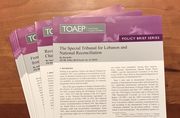Table of contents:
Element:
2. The perpetrator was aware of the factual circumstances that established this status
ICC
In the Katanga Trial Judgement, the Trial Chamber held that:
"Hence, in the instant case, the Chamber considers that the perpetrator must have intentionally killed one or more persons. Such intent will be proven where the perpetrator acted deliberately or failed to act (1) in order to cause the death of one or more persons or (2) whereas he or she was aware that death would occur in the ordinary course of events. Moreover, pursuant to article 8(2)(c)(i) -1(3) of the Elements of Crimes, the perpetrator must also have been aware of the factual circumstances that established the status of the victims."[158]
The Pre-Trial Chamber in the Banda and Jerbo case held that
"For the crime under article 8(2)(c)(i) of the Statute to be established, the perpetrator
must have been aware of the factual circumstances that established the victims' status as
"persons taking no active part in the hostilities."[1]
ICTY
In the Dorđević Appeals Judgement, the Appeals Chamber held that:
"The Trial Chamber stated that, in an internal armed conflict, in case of doubt an individual should be presumed to be a civilian. It considered that this principle entailed, at a minimum, that attacking forces assess and determine whether there is any doubt as to the status of the target. It then concluded that the Serbian forces’ excessive use of force showed that no such assessments were made. Accordingly, the Appeals Chamber is satisfied that the Trial Chamber did not relieve the Prosecution of its burden to prove that the victims were civilians or otherwise protected persons under IHL, nor did it apply an "over-expansive definition" of civilian." [2]
According to the Mucić et al. ("Čelebići") Trial Chamber
"Clearly, if a relevant crime was committed in the course of fighting or the take-over of a town during an armed conflict, for example, this would be sufficient to render the offence a violation of international humanitarian law. Such a direct connection to actual hostilities is not, however, required in every situation."[3]
According to the Blaškić Trial Judgment
"The requirement that an armed conflict exist and that there be a nexus between the crimes alleged and that conflict was presented in detail in the Judgment of the case The Prosecutor v. Zejnil Delalić et al. The Trial Chamber accepts that reasoning."[4]
"In addition to the existence of an armed conflict, it is imperative to find an evident nexus between the alleged crimes and the armed conflict as a whole. This does not mean that the crimes must all be committed in the precise geographical region where an armed conflict is taking place at a given moment. To show that a link exists, it is sufficient that: 'the alleged crimes were closely related to the hostilities occurring in other parts of the territories controlled by the parties to the conflict'"."[5]
"provided that the perpetrator's act fits into the geographical and temporal context of the conflict, he need not have the intent to participate actively in the armed conflict."[6]
According to the Tadić Appeals Chamber:
"[i]t is sufficient that the alleged crimes were closely related to the hostilities occurring in other parts of the territories controlled by the parties to the conflict."[7]
"It is not, however, necessary to show that armed conflict was occurring at the exact time and place of the proscribed acts alleged to have occurred, as the Appeals Chamber has indicated, nor is it necessary that the crime alleged takes place during combat, that it be part of a policy or of a practice officially endorsed or tolerated by one of the parties to the conflict, or that the act be
"in actual furtherance of a policy associated with the conduct of war or in the actual interest of a party to the conflict"[8]
According to the Kunarac et al. Appeals Chamber:
"[w]hat ultimately distinguishes a war crime from a purely domestic offence is that a war crime is shaped by or dependent upon the environment ?¨C the armed conflict ?¨C in which it is committed. It need not have been planned or supported by some form of policy. The armed conflict need not have been causal to the commission of the crime, but the existence of an armed conflict must, at a minimum, have played a substantial part in the perpetrator's ability to commit it, his decision to commit it, the manner in which it was committed or the purpose for which it was committed. Hence, if it can be established [...] that the perpetrator acted in furtherance of or under the guise of the armed conflict, it would be sufficient to conclude that his acts were closely related to the armed conflict."[9]
According to the Tadić Appeal Decision on the Defence Motion for Interlocutory Appeal on Jurisdiction:
"It is sufficient that the alleged crimes were closely related to the hostilities occurring in other parts of the territories controlled by the parties to the conflict."[10]
In regard of the absence of requirement for an official link, the Kunarac et al. Trial Chamber stated:
"It would appear to the Trial Chamber that common Article 3 may also require some relationship to exist between a perpetrator and a party to the conflict. Since, in the present case, the three accused fought on behalf of one of the parties to the conflict, the Trial Chamber does not need to determine whether such a relationship is required, and if so, what the required relationship should be."."[11]
The Kunarac et al. Trial Chamber found:
"It is therefore sufficient that the crimes were closely related to the hostilities occurring in other parts of the territories controlled by the parties to the conflict. The requirement that the act be closely related to the armed conflict is satisfied if, as in the present case, the crimes are committed in the aftermath of the fighting, and until the cessation of combat activities in a certain region, and are committed in furtherance or take advantage of the situation created by the fighting. These requirements are squarely met by the offences under both Indictments, insofar as the Trial Chamber finds the evidence to be sufficient to establish those offences. The Trial Chamber also notes that the three accused, in their capacity as soldiers, took an active part in carrying out military tasks during the conflict, fighting on behalf ofone of the parties to the armed conflict,namely the Serb side and that they therefore knew that an armed conflict was taking place."[12]
The Kunarac et al. Appeals Chamber said:
"In determining whether or not the act in question is sufficiently related to the armed conflict, the Trial Chamber may take into account, inter alia, the following factors: the fact that the perpetrator is a combatant; the fact that the victim is a non-combatant; the fact that the victim is a member of the opposing party; the fact that the act may be said to serve the ultimate goal of a military campaign; and the fact that the crime is committed as part of or in the context of the perpetrator's official duties."[13]
"444. Where a crime punishable under Article 3 of the Statute derives from protections found in Common Article 3, the victims of the alleged violation must have taken no active part in the hostilities at the time the crime was committed. Such victims include members of armed forces who have laid down their arms and those placed hors de combat by sickness, wounds, detention, or any other cause. In addition, the Chamber must be satisfied that “the perpetrator of a Common Article 3 crime knew or should have been aware that the victim was taking no active part in the hostilities when the crime was committed”."
ICTR
The Akayesu Indictement reads:
"As bourgmestre, Jean Paul AKAYESU was responsible for maintaining law and public order in his commune. At least 2000 Tutsi were killed in Taba between April 7 and the end of June, 1994, while he was still in power. The killings in Taba were openly committed and so widespread that, as bourgmestre, Jean Paul AKAYESU must have known about them."[14]
According to the Trial Chambers in Akayesu and Kayeshima and Ruzindana:
"For Akayesu to be held criminally responsible under Article 4 of the Statute, it is incumbent on the Prosecutor to prove beyond a reasonable doubt that Akayesu acted for either the Government or the RPF in the execution of their respective conflict objectives." "[15]
"The Trial Chamber further finds that the actions of Kayeshima and Ruzindana, in the alleged period of time, had no direct connection with the military operations or with the victims of the armed conflict. It has not been shown that there was a direct link between the accused and the armed forces." "[16]
The Akayesu Appeals Chamber, reversing the finding at trial, ruled:
"The Appeals Chamber is of the view that the minimum protection provided for victims under common Article 3 implies necessarily effective punishment on persons who violate it. Now, such punishment must be applicable to everyone without discrimination, as required by the principles governing individual criminal responsibility as laid down by the Nuremberg Tribunal in particular. The Appeals Chamber is therefore of the opinion that international humanitarian law would be lessened and called into question if it were to be admitted that certain persons be exonerated from individual criminal responsibility for a violation of common Article 3 under the pretext that they did not belong to a specific category."[17]
Footnotes:
[1] ICC, Banda and Jerbo Decision on confirmation of charges, 7 March 2007, para. 105.
[2] ICTY, Dorđević Appeals Judgement, 27 January 2014, para. 522.
[3] ICTY, Mucić et al. ("Čelebići") Trial Judgment, 16 November 1998, para. 193.
[4] ICTY, Blaškić Trial Judgment, 15 July 1999, para. 66. (footnotes omitted).
[5] ICTY, Blaškić Trial Judgment, 15 July 1999, para. 66.
[6] ICTY, Blaškić Trial Judgment, 15 July 1999, para. 71.
[7] ICTY, Tadić Appeals Judgment, 15 July 1999, para. 70.
[8] ICTY, Tadić Judgment, 7 May 1997, para. 573. Endorsed in ICTY, Mucić et al. ("Čelebići") Trial Judgment, 16 November 1998, para. 195.
[9] ICTY, Kunarac et al. Appeals Judgment, 12 June 2002, para. 58. The Semanza Trial Chamber endorsed this finding and quoted para. 58 of the Kunarac Appeal Judgment in para. 517 of its Judgment.
[10] ICTY, Tadić Appeal Decision on the Defence Motion for Interlocutory Appeal on Jurisdiction", 2 October 1995, para. 70; "See also Blaškić Trial Judgment, para. 70 and Kunarac Appeal Judgment, para. 64.
[11] ICTY, Kunarac et al. Trial Judgment, 22 February 2001, para. 407.
[12] ICTY, Kunarac et al. Trial Judgment, 22 February 2001, paras. 568, 569.(footnotes omitted).
[13] ICTY, Kunarac et al.Appeal Judgment, 12 June 2002, para. 59.
[14] ICTR, Akayesu Trial Judgment, 2 September 1998, para. 179.
[15] ICTR, Akayesu Trial Judgment, 2 September 1998, para. 640.
[16] ICTR, Kayeshima and Ruzindana Trial Judgment, 21 May 1999, para. 623.
[17] ICTR, Akayesu Appeals Judgment, June 1, 2001, para. 443.







